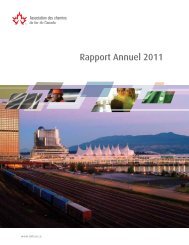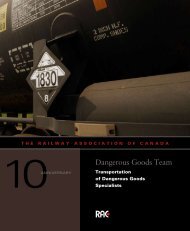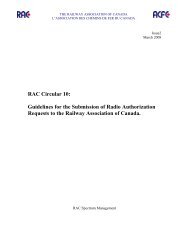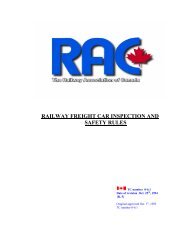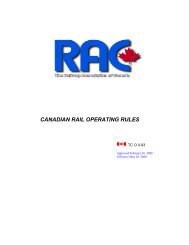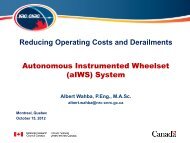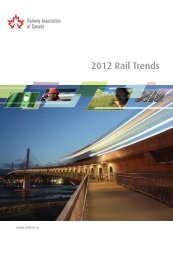pdf 18 mb - Railway Association of Canada
pdf 18 mb - Railway Association of Canada
pdf 18 mb - Railway Association of Canada
- No tags were found...
Create successful ePaper yourself
Turn your PDF publications into a flip-book with our unique Google optimized e-Paper software.
President’s Message | Le message du présidentA poll commissioned by Legermarketing for the <strong>Railway</strong><strong>Association</strong> <strong>of</strong> <strong>Canada</strong> earlier thisyear highlighted some surprisingattitudes by Canadians about freightrail. It seems that a great majority<strong>of</strong> Canadians (87 percent) wouldsupport the government providingfunding for freight rail. Surprising,because the rail industry is not askingthe government for such subsidies,nor does it receive any today.In fact, the railway business in <strong>Canada</strong> is privately ownedand operated. <strong>Railway</strong>s build, operate, maintain and policetheir own tracks and infrastructure, including bridges and tunnels.Although the question was not included in the survey,it wouldn’t be surprising to find that 50% <strong>of</strong> legislators in thecountry believe that freight railways are at least partly ownedor subsidized by government. Perhaps because <strong>of</strong> our greathistory involving railways, there is an enduring myth that governmentstill owns them. This isn’t the case, <strong>of</strong> course, and for2012 railways are on track to spend some $3 billion investingin this considerable infrastructure.Unfortunately, when something has as much history asrail, myths come with the territory and it can take a long timeto change perceptions. Another example is service: as earlyas 2005, some shippers were lobbying the government forregulated service agreements. This led to the 2008 Rail FreightService Review and the appointment <strong>of</strong> Jim Dinning to facilitatediscussions between rail customers and railways and hisfinal report earlier this year. In other words, a lot <strong>of</strong> processspread over an extended period <strong>of</strong> time. However, duringthe period from 2008 to 2011, service improved by 50 percent,according to data supplied by the shippers themselves.Although this improvement in service was understood in themarketplace, the myth perpetuated in Ottawa and the FederalGovernment introduced the “Fair Rail Freight Service Act,” onDece<strong>mb</strong>er 11.A related myth is that shippers are paying a high price forrail service in <strong>Canada</strong>. The popular thinking is that <strong>Canada</strong> is alarge country, geographically, and so it stands to reason thatour freight rates would be higher to <strong>of</strong>fset the investmentthat needs to go into infrastructure. Again, this perceptionis dead wrong. According to data from the World Bank andthe American <strong>Association</strong> <strong>of</strong> Railroads, we know that <strong>Canada</strong>and the US have the lowest freight rates in the world. Lowerthan China and Russia, where there are considerable publicsubsidies for operations and infrastructure and lower thanEuropean countries, which are small and densely populated.Yet another myth, a holdover from the days <strong>of</strong> governmentmonopoly (or maybe from the Board Game), is “marketpower”. More than one study has been done about the ratesthat Canadian railroads charge for their services, includingUn sondage réalisé plus tôt cette année par LégerMarketing pour le compte de L’<strong>Association</strong> des cheminsde fer du <strong>Canada</strong> a mis en lumière certaines opinionssurprenantes des Canadiens à l’égard du transport ferroviairemarchandises. Il se<strong>mb</strong>le les Canadiens appuieraient engrande majorité (87 %) le financement public du transportferroviaire marchandises, ce qui est d’autant plus étonnantque le secteur ferroviaire ne demande pas au gouvernementde lui verser des subventions et qu’il n’en reçoit aucuneactuellement.En fait, les entreprises ferroviaires au <strong>Canada</strong> sontdétenues et exploitées par des intérêts privés. Les cheminsde fer construisent, exploitent, entretiennent et contrôlentleurs propres voies et leur infrastructure, dont les ponts etles tunnels. Bien que la question n’ait pas été posée dansle sondage, il ne serait pas surprenant d’apprendre que 50% des législateurs au pays croient que les chemins de fermarchandises appartiennent au moins partiellement à l’Étatou bénéficient de subventions gouvernementales. Peut-êtrequ’en raison de notre formidable histoire à laquelle sont associésles chemins de fer, il existe un mythe persistant voulantque ceux-ci soient encore détenus par l’État. Bien entendu, cen’est pas le cas et, selon les prévisions, les entreprises ferroviairesinvestiront en 2012 quelque 3 milliards de dollars dansleur importante infrastructure.Malheureusement, un secteur si imprégné d’histoirecomme le rail a suscité l’émergence de mythes qui se sontsolidement enracinés, et l’évolution des perceptions demandedu temps. Prenons l’exemple du service : dès 2005, certainsexpéditeurs exerçaient des pressions auprès du gouvernementafin d’obtenir des ententes de service réglementées.C’est ce qui a suscité la tenue, en 2008, de l’Examen desservices de transport ferroviaire de marchandises et la nominationde monsieur Jim Dinning pour faciliter les discussionsentre les clients et les chemins de fer. M. Dinning a publiéson rapport final plus tôt cette année. Autrement dit, il y a euun processus intensif qui s’est étendu sur une longue période.Or, dans l’intervalle de 2008 à 2011, le service s’est amélioréde 50 %, selon des données fournies par les expéditeurs euxmêmes.Bien que cette amélioration du service ait été reconnuesur le marché, le mythe a perduré à Ottawa et, le 11déce<strong>mb</strong>re, le gouvernement fédéral a annoncé l’introductiond’un projet de loi intitulé Loi sur les services équitables detransport ferroviaire des marchandises.Un autre mythe connexe circule selon lequel les expéditeurspaieraient un prix élevé pour le service ferroviaire au<strong>Canada</strong>. Selon la croyance populaire, il se<strong>mb</strong>le raisonnable,compte tenu de l’étendue géographique du <strong>Canada</strong>, que nostarifs marchandises soient plus élevés pour contrebalancer lesinvestissements nécessaires dans l’infrastructure. Encore unefois, il s’agit d’une perception complètement fausse. Grâce àdes données fournies par la Banque mondiale et l’<strong>Association</strong><strong>of</strong> American Railroads, nous savons que le <strong>Canada</strong> et les<strong>Railway</strong> <strong>Association</strong> <strong>of</strong> <strong>Canada</strong> / <strong>Association</strong> des chemins de fer du <strong>Canada</strong> 7




